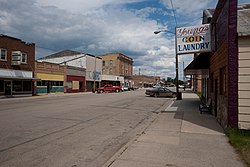Ellendale, North Dakota
Ellendale is a city in Dickey County, North Dakota, United States. It is also the county seat.[4] The population was 1,125 at the 2020 census.[3] Ellendale was founded in 1882. It is the home of Trinity Bible College, located on the former campus of the North Dakota State Normal and Industrial School and the Ellendale Opera House currently under renovation.
 | |
 Location of Ellendale, North Dakota | |
| Coordinates: 46°00′15″N 98°31′31″W / 46.00417°N 98.52528°WCoordinates: 46°00′15″N 98°31′31″W / 46.00417°N 98.52528°W | |
| Country | United States |
| State | North Dakota |
| County | Dickey |
| Founded | 1882 |
| Area | |
| • Total | 1.42 sq mi (3.67 km2) |
| • Land | 1.42 sq mi (3.67 km2) |
| • Water | 0.00 sq mi (0.00 km2) |
| Elevation | 1,453 ft (443 m) |
| Population | |
| • Total | 1,125 |
| • Density | 793.93/sq mi (306.48/km2) |
| Time zone | UTC-6 (Central (CST)) |
| • Summer (DST) | UTC-5 (CDT) |
| ZIP code | 58436 |
| FIPS code | 38-23220 |
| GNIS feature ID | 1036021[2] |
| Highways | US 281, ND 11 |
| Website | ellendalend.com |
History
Ellendale was created as county seat of the newly formed Dickey County in 1882. That same year saw the arrival of the Chicago, Milwaukee, St. Paul and Pacific Railroad into the area.[5]
Ellendale is named for the wife of S. S. Merrill.[6]
Geography
Ellendale is at 46°0′11″N 98°31′23″W / 46.00306°N 98.52306°W (46.002987, -98.523112).[7]
According to the United States Census Bureau, the city has a total area of 1.42 square miles (3.68 km2), all land.[1]
Demographics
| Historical populations | |||
|---|---|---|---|
| Census | Pop. | %± | |
| 1890 | 761 | ||
| 1900 | 750 | −1.4% | |
| 1910 | 1,389 | 85.2% | |
| 1920 | 1,334 | −4.0% | |
| 1930 | 1,264 | −5.2% | |
| 1940 | 1,517 | 20.0% | |
| 1950 | 1,759 | 16.0% | |
| 1960 | 1,800 | 2.3% | |
| 1970 | 1,517 | −15.7% | |
| 1980 | 1,967 | 29.7% | |
| 1990 | 1,798 | −8.6% | |
| 2000 | 1,559 | −13.3% | |
| 2010 | 1,394 | −10.6% | |
| U.S. Decennial Census[8] 2020 Census[3] | |||
As of the census of 2020, there were 1,125 people, 455 households, and 256 families living in the city.[3][9]
References
- ↑ 1.0 1.1 "ArcGIS REST Services Directory". United States Census Bureau. Retrieved September 20, 2022.
- ↑ 2.0 2.1 U.S. Geological Survey Geographic Names Information System: Ellendale, North Dakota
- ↑ 3.0 3.1 3.2 3.3 "Profile of General Population and Housing Characteristics: 2020 Demographic Profile Data (DP-1): Ellendale city, North Dakota". United States Census Bureau. Retrieved February 18, 2024.
- ↑ National Association of Counties. "NACo County Explorer". Retrieved February 18, 2024.
- ↑ Hellmann, Paul T. (May 13, 2013). Historical Gazetteer of the United States. Routledge. p. 835. ISBN 978-1135948597. Retrieved 30 November 2013.
- ↑ Gannett, Henry (1905). The Origin of Certain Place Names in the United States. Govt. Print. Off. pp. 117.
- ↑ "US Gazetteer files: 2010, 2000, and 1990". United States Census Bureau. 2011-02-12. Retrieved 2011-04-23.
- ↑ United States Census Bureau. "Census of Population and Housing". Retrieved January 30, 2014.
- ↑ "P16: HOUSEHOLD TYPE". United States Census Bureau. Retrieved February 18, 2024.